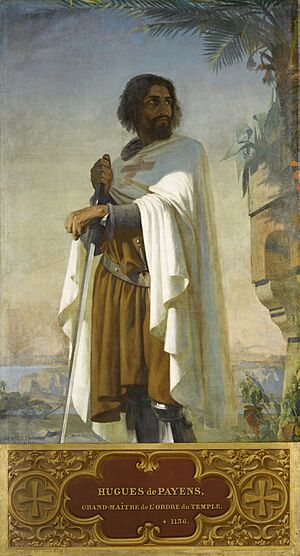Hugues de Payens facts for kids
Quick facts for kids
Hugues de Payens
|
|
|---|---|

Portrait by Henri Lehmann, 1841
|
|
| 1st Grand Master of the Knights Templar | |
| In office c. 1119–1136 |
|
| Preceded by | Order established |
| Succeeded by | Robert de Craon |
| Personal details | |
| Born | c. 1070
|
| Died | 24 May 1136 (aged 66) Kingdom of Jerusalem |
| Known for | Founding member and first Grand Master of the Knights Templar |
Hugues de Payens, also known as Hugo de Paganis, was a French knight born around 1070. He is famous for being a co-founder and the very first leader, or Grand Master, of the Knights Templar. This was a special group of warrior monks. With the help of Bernard of Clairvaux, he created the Latin Rule, which was like a rulebook for the Templar Order.
Contents
Understanding His Name
Hugues de Payens' name appears in different ways in old documents. In Latin, he was called Latin: Hugo de Paganis. Early French writings sometimes used Hugo de Peans. Later, in French, his name became French: Hugues de Payens or French: Payns. This is the name most people know him by today.
Where Did Hugues Come From?
Historians are not completely sure where Hugues de Payens was born. There are two main ideas about his origin.
Italian Roots?
Some old writings suggest that Hugues de Payens came from a town called Nocera dei Pagani in Southern Italy. Writers from the 16th century and later supported this idea. Even the Old Catholic Encyclopedia from 1911 mentioned Nocera as his birthplace.
French Origins?
However, a very old French translation of a history book from around 1200 says he was from "Payens near Troyes." This refers to a small village called Payns, close to Troyes in eastern France. This idea is supported by other clues.
For example, a man named Hugo de Pedano was mentioned in documents from 1085 to 1113. He was part of the court of Count Hugh I of Champagne. This Count Hugh was a big supporter of the Templars. The rules for the Templar Order were even approved at a meeting in Troyes in 1129. A Templar base was later built at Payns. Many historians now believe he was from Payns, France.
Starting the Knights Templar
Hugues de Payens likely traveled to the Holy Land with Count Hugh of Champagne. He stayed there after the Count returned to France. In 1120, his name appeared in a document from Jerusalem. By 1125, he was called "Master of the Knights of the Temple."
Why the Order Was Formed
Around 1119, Hugues de Payens and eight other knights decided to form a new group. Their main goal was to protect Christian pilgrims traveling to the Holy Land. These pilgrims often faced dangers on their journeys. The knights wanted to make the roads safer.
Gaining Royal Approval
Hugues de Payens and his fellow knights approached Baldwin II of Jerusalem, who was the king at the time. The king approved their idea. He gave them a place to live in the Temple Mount area of Jerusalem. This is how they got the name "Knights of the Temple" or "Templars."
The other founding knights included Godfrey de Saint-Omer, Payen de Montdidier, and André de Montbard. Count Hugh of Champagne himself joined the Knights Templar in 1125.
Growing the Order
In the late 1120s, Hugues de Payens traveled to Europe. He met with kings and nobles to ask for support for the new Order. He wanted more knights to join and more money to help their mission.
During this trip, he helped set up the first Templar houses in England and Scotland. The Latin Rule, which guided the Templars' way of life, was officially approved in 1129 at the Council of Troyes. This rulebook was put together by Hugues de Payens and Bernard of Clairvaux.
As the first Grand Master, Hugues de Payens led the Knights Templar for about 20 years. He helped it grow into a very important and powerful group, both militarily and financially.
His Final Days
Hugues de Payens passed away in 1136. The exact details of his death are not fully known. However, the Templars remembered him every year on May 24th. It is thought he died of old age. He was followed as Grand Master by Robert de Craon.
Images for kids


